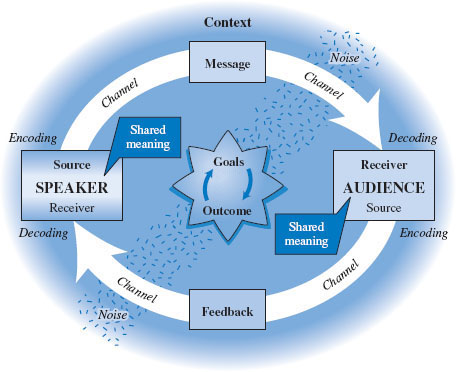Public Speaking as an Interactive Communication Process
Printed Page 7
In any communication event, including public speaking, several elements are present. These include the source, the receiver, the message, the channel, and shared meaning (see Figure 1.1).
The source, or sender, is the person who creates a message. Creating, organizing, and producing the message is called encoding—the process of converting thoughts into words.
The recipient of the source’s message is the receiver, or audience. The process of interpreting the message is called decoding. Audience members decode the meaning of the message selectively, based on their own experiences and attitudes. Feedback, the audience’s response to a message, can be conveyed both verbally and nonverbally.

The message is the content of the communication process: thoughts and ideas put into meaningful expressions, expressed verbally and nonverbally. The medium through which the speaker sends a message is the channel. If a speaker delivers a message in front of a live audience, the channel is the air through which sound waves travel. Other channels include the telephone, television, computers, and written correspondence.
Noise is any interference with the message. Noise can disrupt the communication process through physical sounds such as cell phones ringing and people talking, through psychological distractions such as heated emotions, or through environmental interference such as a frigid room or the presence of unexpected people.
Shared meaning is the mutual understanding of a message between speaker and audience. The lowest level of shared meaning exists when the speaker has merely caught the audience’s attention. As the message develops, a higher degree of shared meaning is possible. Thus listener and speaker together truly make a speech a speech—they “co-create” its meaning.
Two other factors are critical to consider when preparing and delivering a speech—context and goals. Context includes anything that influences the speaker, the audience, the occasion—and thus, ultimately, the speech. In classroom speeches, the context would include (among other things) recent events on campus or in the outside world, the physical setting, the order and timing of speeches, and the cultural orientations of audience members. Successful communication can never be divorced from the concerns and expectations of others.
Part of the context of any speech is the situation that created the need for it in the first place. All speeches are delivered in response to a specific rhetorical situation, or a circumstance calling for a public response.10 Bearing the context and rhetorical situation in mind ensures that you remain audience centered—that is, that you keep the needs, values, attitudes, and wants of your listeners firmly in focus.
A clearly defined speech purpose or goal—what you want the audience to learn or do as a result of the speech—is a final prerequisite for an effective speech. Establishing a speech purpose early on will help you proceed through speech preparation and delivery with a clear focus in mind.